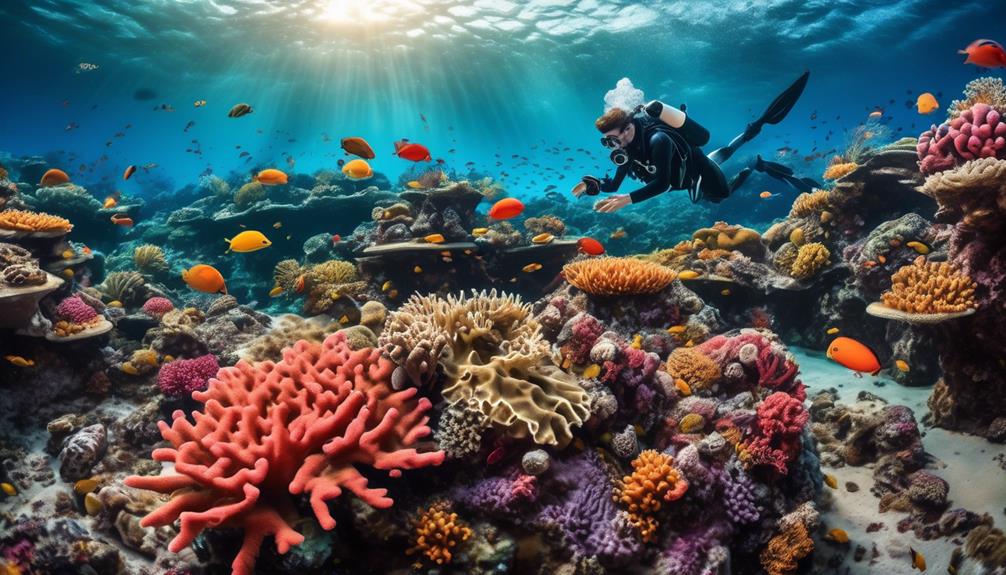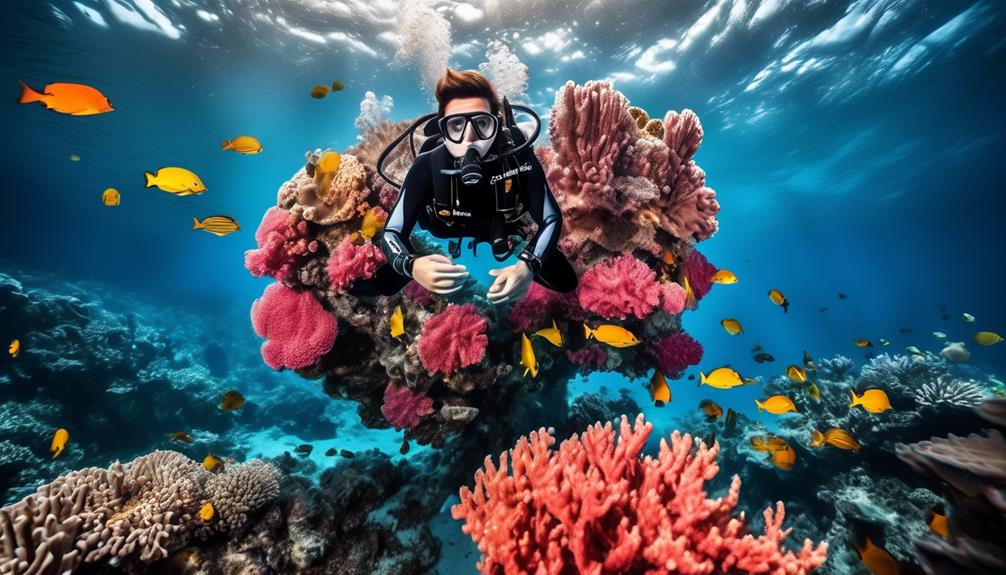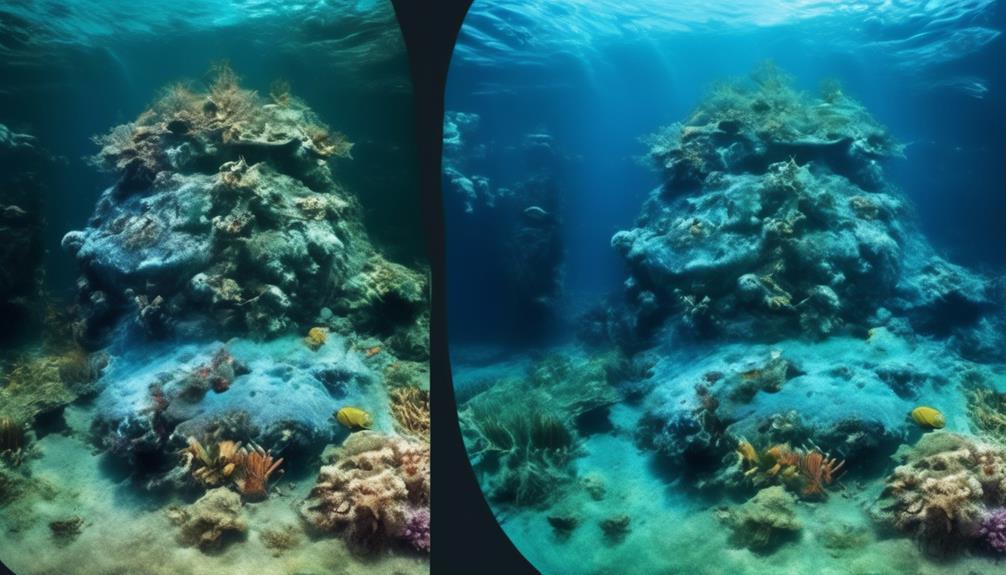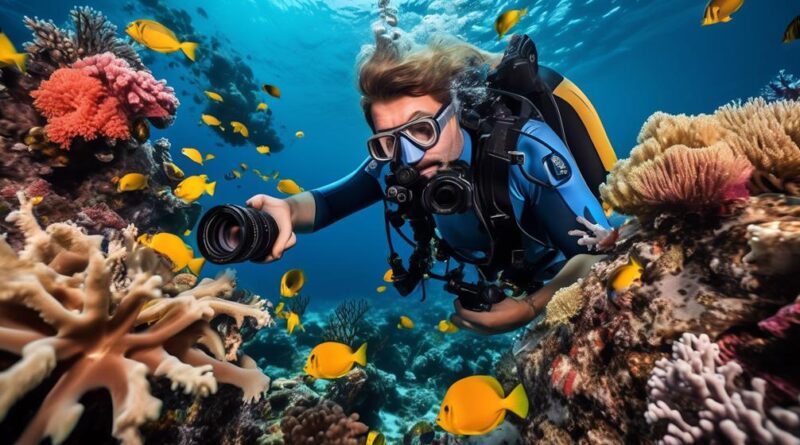10 Best Strategies for Exceptional Underwater Diving Photography
Imagine yourself descending into the depths of the ocean, surrounded by a mesmerizing world of vibrant marine life and stunning coral formations.
As an underwater photographer, you are presented with a unique set of challenges and opportunities to capture the beauty of this underwater realm.
From selecting the right equipment to mastering composition and understanding lighting, there are key strategies that can elevate your underwater diving photography to exceptional levels.
Whether you're a novice or seasoned underwater photographer, these strategies will help you capture breathtaking images that truly showcase the wonders of the ocean.
Equipment Selection
When choosing equipment for underwater diving photography, consider the specific needs of your dive and the type of photography you plan to capture. Camera settings and maintenance are crucial for achieving optimal results.
Underwater photography requires careful attention to camera settings to adjust for the loss of color and light at depth. Ensure that your camera is properly maintained and waterproofed to avoid any malfunctions during your dive. Regularly check the O-rings and seals to prevent water damage.
Lens selection and maintenance are equally important for underwater photography. Choose a lens that suits the type of photography you plan to do, whether it's wide-angle shots of coral reefs or macro photography of tiny sea creatures. Keep your lenses clean and free from saltwater residue, which can affect image quality. A small, soft brush and lens cleaning solution are essential for maintaining your lenses in top condition.
Proper equipment care and attention to detail with camera settings and lens maintenance will significantly impact the quality of your underwater diving photography. Taking the time to understand your specific needs and the type of photography you aim to capture will guide you in selecting the right equipment and maintaining it effectively.
Understanding Lighting
To capture striking underwater diving photographs, understanding how light behaves in the aquatic environment is crucial. When it comes to underwater photography, light behaves differently than it does on land.
To make the most of the available light, consider the following:
- Natural Light: Understanding how natural light filters through the water is essential. Different colors of light are absorbed at different depths, affecting the overall look of your photographs. Make use of natural light to create stunning effects and vibrant colors in your underwater images.
- Artificial Light: Using artificial light sources such as strobes or video lights can help you illuminate subjects and fill in shadows in the underwater environment. Experiment with different angles and intensities of artificial light to achieve the desired effects in your photographs.
- Creative Angles: Explore creative angles to make the most of the available light. Shooting upward can create dramatic silhouettes against the light, while shooting downward can capture the intricate details of the underwater landscape. Experimenting with different angles can add depth and visual interest to your underwater images.
Understanding exposure settings is also crucial for capturing well-lit underwater photographs. Adjusting your camera's exposure settings to accommodate the unique lighting conditions underwater can make a significant difference in the quality of your images.
Mastering Composition

Explore diverse framing techniques to enhance the visual impact of your underwater diving photographs. Mastering composition is crucial for creating captivating images.
One fundamental technique to elevate your underwater diving photography is the rule of thirds. This rule suggests dividing your image into nine equal parts using two equally spaced horizontal and vertical lines. This creates four points where the lines intersect, and these points are where the eyes are naturally drawn. By placing your main subject along these lines or at the points of intersection, you can achieve a more balanced and visually appealing composition.
Another essential aspect to consider is depth perception. Underwater environments offer a unique opportunity to play with depth and perspective. Utilize elements in the foreground, such as corals or rocks, to add a sense of depth to your images. This not only creates a more immersive experience for the viewer but also enhances the overall composition of your photographs.
Experiment with different angles and perspectives to highlight the three-dimensional nature of the underwater world.
Utilizing Filters
Enhance the color and clarity of your underwater diving photographs by utilizing filters that are specifically designed for underwater photography. When it comes to underwater photography, the right filter can make a world of difference in the quality of your images. Here are several ways filters can help you capture stunning underwater photographs:
- Filter types: There are various types of filters designed specifically for underwater photography, such as color-correction filters and polarizing filters. Color-correction filters can help bring back the red and orange hues that are often lost as you descend deeper underwater, resulting in more vibrant and natural-looking photos. Polarizing filters can reduce glare and reflections on the water's surface, allowing for greater clarity and detail in your images.
- Underwater visibility: The visibility underwater can vary greatly depending on factors such as water depth, sediment, and natural light conditions. Utilizing the right filter can help compensate for these variations in visibility, ensuring that your photographs accurately capture the beauty of the underwater world. Filters can enhance contrast and reduce the effects of haze, resulting in sharper and more defined images, even in challenging visibility conditions.
- Artistic effects: In addition to improving color and clarity, filters can also be used to create artistic effects in your underwater photographs. For instance, using a creative filter such as a color-enhancing filter can add a touch of creativity and uniqueness to your images, allowing you to experiment with different visual styles and moods.
Perfecting Buoyancy Control

Perfecting buoyancy control while underwater diving is crucial for capturing stunning photographs, as it allows you to maintain stability and precision in your shots, complementing the effects achieved through the use of filters.
To achieve optimal buoyancy control, mastering breathing techniques and body positioning is essential. When diving, focus on controlling your breath by taking slow, deep breaths, and exhaling fully. This helps in maintaining a consistent buoyancy level, preventing sudden rises or descents that can disrupt your photography.
Additionally, body positioning plays a vital role in buoyancy control. By positioning your body parallel to the water's surface, you can minimize resistance and achieve a smoother glide, allowing you to capture images with minimal disturbance to the marine environment.
Furthermore, mastering buoyancy control not only enhances the quality of your underwater photographs but also contributes to the safety of your dive. Proper buoyancy control reduces the risk of accidental damage to the delicate coral reefs and marine life, ensuring that your photography doesn't harm the underwater ecosystem.
It also enables you to conserve energy, extending your dive time and providing more opportunities to capture captivating images.
Capturing Marine Life Behavior
How can you effectively capture the intriguing behavior of marine life through underwater diving photography?
When it comes to capturing marine life behavior, it's essential to be patient and observant. To truly capture the essence of marine life interaction, you need to immerse yourself in their natural habitat and be ready to seize the moment when it happens. Here are a few tips to help you capture the most captivating moments of marine life behavior:
- Observe and Understand: Spend time observing the marine life in their natural habitat. Understanding their behavior will help you anticipate their movements and capture the most intriguing moments.
- Patience is Key: Marine life behavior can be unpredictable, so patience is crucial. Spend time in their environment, and be ready to wait for the perfect moment to capture their interactions.
- Immerse Yourself: To capture authentic marine life behavior, immerse yourself in their world. This means spending time in the water, understanding their movements, and being ready to photograph their natural interactions.
Post-Processing Techniques

After capturing captivating moments of marine life behavior through underwater diving photography, the next step is to refine and enhance your images using post-processing techniques.
Color correction is crucial in underwater photography as water absorbs different colors at different depths, often resulting in a loss of vibrancy and clarity in your images. Adjusting the color balance and saturation can help restore the natural colors of the underwater world.
Additionally, image sharpening is essential to bring out the intricate details of marine life and the surrounding environment, creating a more striking and immersive visual experience for viewers.
Noise reduction is another key post-processing technique for underwater diving photography. Water tends to introduce grainy or speckled noise in images, especially in low light conditions. Using noise reduction tools can help mitigate these issues, resulting in smoother and cleaner images.
Exposure adjustment is also vital, as the challenging lighting conditions underwater can lead to overexposed or underexposed areas in your photos. By fine-tuning the exposure, you can ensure that the important elements in your images are properly illuminated and balanced, enhancing the overall visual impact of your underwater photography.
Safety Considerations
To ensure your safety during underwater diving photography, always prioritize thorough equipment checks and adherence to established diving protocols.
Dive preparation and risk assessment are crucial components of safe underwater photography. Before descending, double-check that all your gear is functioning properly, including your camera housing, diving mask, and breathing apparatus. Conduct a thorough risk assessment of the dive site to identify potential hazards such as strong currents, marine life, or underwater obstructions.
Emergency procedures and communication techniques are vital for safe underwater diving photography. Familiarize yourself with emergency protocols and signals before entering the water. Make sure you and your diving buddy have a clear understanding of each other's hand signals and emergency procedures. In the event of an emergency, knowing how to communicate effectively underwater can make a critical difference. Practice using underwater communication devices or signals to convey important messages to your dive partner or the surface support team.
Maintaining a heightened awareness of your surroundings and staying attuned to your equipment and dive conditions are fundamental to ensuring a safe and successful underwater photography session. By prioritizing dive preparation, conducting thorough risk assessments, familiarizing yourself with emergency procedures, and honing your communication techniques, you can mitigate potential risks and focus on capturing stunning underwater images.
Frequently Asked Questions
How Can I Effectively Capture the Unique Colors and Textures of Underwater Landscapes in My Photography?
To capture the unique colors and textures of underwater landscapes in your photography, use lighting techniques and color correction. Invest in underwater equipment and remember composition tips. These will help you create exceptional underwater images.
What Are Some Tips for Capturing Clear, Sharp Images in Low Visibility or Murky Water Conditions?
In low light conditions or murky water, aim for clear shots by using a powerful underwater flashlight or adjusting your camera settings for low light. Additionally, consider using a wide-angle lens to capture more light and improve water clarity.
Are There Any Specific Techniques for Capturing the Movement and Behavior of Larger Marine Animals, Such as Sharks or Dolphins?
To capture the movement and behavior of larger marine animals like sharks or dolphins, try using fast shutter speeds and tracking their movements. Anticipate their actions and position yourself for the best angle. Stay calm to avoid startling them.
How Can I Best Convey the Sense of Depth and Scale in My Underwater Photographs?
To convey perspective in your underwater photos, experiment with creative lighting techniques. Use shadows and highlights to create depth and emphasize scale. By playing with light and dark, you can capture the vastness of the underwater world.
Are There Any Ethical Considerations or Guidelines for Photographing Marine Life in Their Natural Habitat?
When photographing marine life in their natural habitat, it's essential to consider ethical considerations and follow guidelines. Respect the environment, avoid disturbing the animals, and prioritize their well-being. Always prioritize the welfare of the marine life.
Conclusion
Now that you have learned the 10 best strategies for exceptional underwater diving photography, it's time to put them into practice.
Remember to carefully select your equipment, understand lighting, and master composition.
Utilize filters, perfect buoyancy control, and capture marine life behavior.
Don't forget about post-processing techniques and always consider safety.
With these strategies in mind, you'll be well on your way to capturing stunning underwater photography.
Happy diving!
